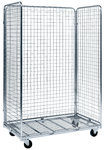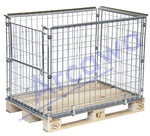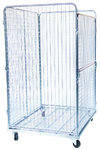Arcawa Webshop Roll Containers Guide to choosing the right wheels
Guide to choosing the right wheels
Here we would like to provide you with important information to help you make the right choice of wheels and castors for your individual application.
Castor types
Swivel castors
Swivel castors can be swivelled and enable a constant change of direction thanks to the bearing incorporated in the housing. Swivel castors can also be fitted with a brake that locks the wheel movement and swivelling movement at the same time. If only the swivelling movement of the fork is blocked, this is a directional locking device.
Screw-on plates, steel insertion pins for tubes and fastening by means of a screw via a back hole in the swivel housing have proven to be the most suitable fastening elements.
Fixed castors
Fixed castors cannot be swivelled and provide the means of transport or machines with directional stability. Bolt-on plate fastenings have generally proved to be the best fastening elements.
Tyres on the running surfaces
Polypropylene (PP)
Polypropylene is the cheapest alternative. It is characterised by high chemical resistance, medium load capacity, break-proof under medium loads, medium service life (relatively high wear on rough floors), smooth running on smooth floors, low rolling resistance. Less suitable for uneven floors. Temperature resistance: from 0 °C to + 80 °C, therefore not suitable in frost areas. Rather loud
Polyamide (PA)
Polyamide wheels are more durable, have significantly less abrasion and are more resistant to breakage than PP wheels. Polyamide wheels ensure smooth running on smooth floors, high chemical resistance, low starting resistance and maintenance-free handling. Less suitable for uneven floors. Temperature resistance: from -30°C to +80°C, therefore very suitable in frosty areas. Rather loud
Solid rubber
Frequently used standard wheel for transport equipment. Quiet and floor-friendly, available in black (may leave marks on floors) or grey (non-marking). Rubber wheels tend to flatten the running surface under high continuous loads (PP, PA and polyurethane are recommended). Solid rubber castors are also suitable for uneven floor surfaces.
Solid rubber elastic (super ride comfort)
Elastic, shock-absorbing ride behaviour. Better suspension and lower rolling resistance as well as higher load capacity than standard solid rubber. It rolls very quietly, is gentle on the floor and leaves no marks. Rubber wheels tend to flatten the running surface under high continuous loads (PP, PA and polyurethane are recommended). Elastic castors are also suitable for uneven floor surfaces. Should not be exposed to chemical substances.
Thermoplastic rubber (TPE)
Non-marking tyres and treads characterised by durability and economy. Very quiet running and significantly higher load capacity than solid rubber. Rather low resistance to chemical alkalis. Also suitable for uneven floors.
Polyurethane
Polyurethane is a very high-quality, durable wheel material that can be used wherever other materials no longer fulfil the requirements. The main properties of polyurethane are Long service life due to low wear, high load-bearing capacity even under dynamic loads, non-marking and floor-friendly running, good resistance to chemical substances, cut-resistant to metal shavings.
Wheel bearing
A high-quality wheel bearing is the best prerequisite for optimum running properties and therefore plays a decisive role in determining the quality of a castor. A distinction is made between the following bearing types:
1. plain bearing
The plain bearing is a simple, inexpensive, insensitive, normally maintenance-free and usually corrosion-resistant wheel bearing. Plain bearings are mainly used for apparatus castors and transport equipment castors if they are only operated at low speeds and not too frequently. Under special conditions, e.g. dryness, high air dust content and high mileage, grease or oil lubrication is recommended.
2. roller bearing
The roller bearing is a robust, resistant, largely maintenance-free wheel bearing. Roller bearings have proven themselves primarily for transport equipment castors with frequent use. The roller bearing consists of steel rollers mounted in a plastic or steel cage. These rollers roll between the axle tube and the wheel hub. As rolling friction rather than sliding friction occurs during rotation around the axle, the rolling resistance of the wheel is relatively low, even under high loads.
Roller bearings are greased with a long-life grease when the wheel series is assembled and therefore do not normally need to be relubricated.
3. ball bearing
The ball bearing fulfils the highest demands in terms of load capacity, running properties (even at higher speeds) and resistance to environmental influences. Ball bearings are primarily used in technically demanding transport equipment castors and heavy-duty castors. Wheel bearings fitted with sealed ball bearings must not be relubricated, as this can damage the bearing.
Ball bearings are fitted with long-life grease during assembly. As standard, 2 ball bearings are mounted in the hub, which are kept at a distance by means of a spacer sleeve. This wheel bearing offers very precise, smooth running.
Load capacity
The required load capacity when using 4 castors is calculated as follows:
Load capacity per castor = (trolley's own weight + payload) divided by 3, as often only three out of four wheels are on the ground on uneven floors. In addition, overloading can occur for a short time if the trolley runs over obstacles. The load capacities specified in our shop are valid for travelling speeds of up to 4 km/h. For poor ground conditions and frequent top speeds, larger wheel diameters with a higher load capacity should be selected.






